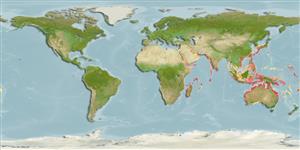>
Eupercaria/misc (Various families in series Eupercaria) >
Haemulidae (Grunts) > Plectorhinchinae
Etymology: Plectorhinchus: Greek, plektos = plaited + Greek, rhyngchos = snout (Ref. 45335).
More on author: Cuvier.
Environment: milieu / climate zone / depth range / distribution range
Ökologie
seewasser riff-verbunden; tiefenbereich 2 - 80 m (Ref. 90102). Tropical; 35°N - 38°S, 28°E - 172°E
Indo-West Pacific: Red Sea south to Transkei, South Africa and east to Papua New Guinea, north to southern Japan, south to western Australia and New South Wales (Ref. 9710).
Length at first maturity / Size / Gewicht / Alter
Maturity: Lm ?, range 34 - ? cm
Max length : 60.0 cm TL Männchen/unbestimmt; (Ref. 2799)
Rückenflossenstacheln (insgesamt): 12 - 13; Rückenflossenweichstrahlen (insgesamt): 19-22; Afterflossenstacheln 3; Afterflossenweichstrahlen: 7. This species is distinguished by the following characters: chin with 6 pores, no median pit; gill rakers on first gill arch 11-14 + 1 + 16-19 = 26-34; D XII-XIII (mostly XIII),19-22, 4th or 5th spines longest; lips fleshy, moderately swollen with age; scales ctenoid (rough to touch); lateral line tubed scales about 53-60; body depth 2.5-2.8 in SL; caudal fin slightly rounded in juveniles becoming emarginate in adults. Colour of body bluish grey, juveniles with golden or rusty orange stripes along the body that break into a reticulate pattern and later form small spots that may be lost with age or remain as lines, or lines of spots on head (Ref. 47695, 90102).
Inhabits coastal inshore waters near sheltered reefs, lagoons, sandbanks and seagrass areas, solitarily or in groups (Ref. 47695, 90102). Adults usually on silty reefs at moderate depths, or in current channels occasionally inshore; juveniles enter estuaries and harbors (Ref. 48635). Feeds on small fishes and crustaceans (Ref. 5213). Taken by handline and spear. A common species marketed fresh, a small quantity is salted, good food fish (Ref. 47695). Maximum depth reported taken from Ref. 9773.
Life cycle and mating behavior
Geschlechtsreife | Fortpflanzung | Ablaichen | Eier | Fecundity | Larven
Oviparous, distinct pairing during breeding (Ref. 205).
Masuda, H., K. Amaoka, C. Araga, T. Uyeno and T. Yoshino, 1984. The fishes of the Japanese Archipelago. Vol. 1. Tokai University Press, Tokyo, Japan. 437 p. (text). (Ref. 559)
IUCN Rote Liste Status (Ref. 130435)
Warning: mysqli::__construct(): (HY000/1040): Too many connections in /var/www/html/includes/func_getlabel.php on line 46
Can't connect to MySQL database (fbapp). Errorcode: Too many connections
